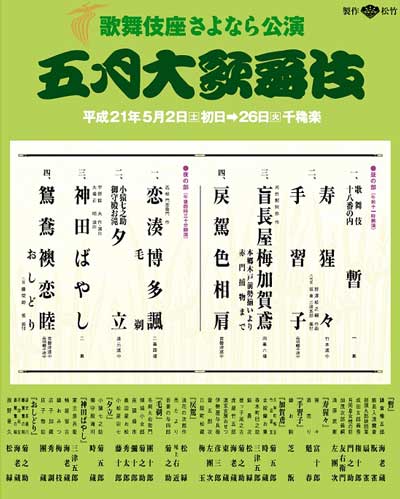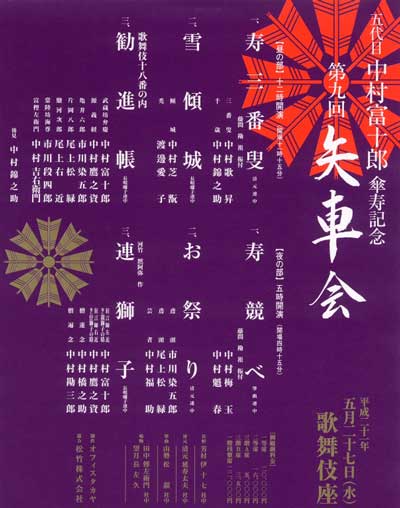| MAY 2009 |
|
6 shows in T˘ky˘ (Kabukiza, Shinbashi Enbuj˘, National Theatre), 1 in Nagoya (Chűnichi Theatre) and 1 in Ky˘to (Minamiza)!
|
| Kabukiza (T˘ky˘) |  |
| Dates | 2 ~ 26 May 2009 (Gogatsu ďkabuki) Kabukiza Sayonara K˘en |
| MatinÚe | |
| Evening |
Koi Minato Hakata no Hitofushi (Kezori) Yűdachi Kanda Bayashi |
| Casting |
Ichikawa Danjűr˘, Onoe Kikugor˘, Sakata T˘jűr˘, Nakamura Tokiz˘, Band˘ Mitsugor˘, Nakamura Tomijűr˘, Nakamura Shikan, Ichikawa Ebiz˘, Onoe Kikunosuke, Nakamura Baigyoku, Nakamura Kaishun, Nakamura Kanjaku, Nakamura Senjaku, Ichikawa Danz˘, Ichikawa Sadanji, Kataoka Hidetar˘, Band˘ Yajűr˘, Onoe Sh˘roku, Band˘ Hikosabur˘, Nakamura T˘z˘, Band˘ Shűch˘, Ichikawa Monnosuke, Kawarasaki Gonjűr˘, ďtani Tomoemon, Nakamura Baishi |
| Comments |
5th of the 16 Kabukiza Sayonara K˘en, the Kabukiza Farewell Performances, which will be held up to April 2010.
|
 |
| Kabukiza (T˘ky˘) |  |
| Dates | 27 May 2009 (Yaguruma no Kai) |
| MatinÚe |
Kotobuki Sanbas˘ Yuki Keisei |
| Evening |
Kotobuki Kurabe |
| Casting |
Nakamura Tomijűr˘, Nakamura Kichiemon, Nakamura Kanzabur˘, Nakamura Shikan, Nakamura Baigyoku, Nakamura Kaishun, Nakamura Hashinosuke, Nakamura Kinnosuke, Ichikawa Danshir˘, Nakamura Fukusuke, Ichikawa Somegor˘, Onoe Sh˘roku, Nakamura Kash˘, Onoe Ukon, Nakamura Takanosuke |
| Comments |
Nakamura Tomijűr˘ celebrates at the Kabukiza his 80th birthday. This is an important age and it is a custom to celebrate it with a sanju kinen performance, which is this time a short dance program of the association Yaguruma no Kai (yaguruma is the mon of Nakamura Tomijűr˘). The Living National Treasure performs the role of Musashib˘ Benkei in the spectacular dance-drama "Kanjinch˘". He also performs with his son Nakamura Takanosuke in the dance "Renjishi". |
 |
| Shinbashi Enbuj˘ (T˘ky˘) |
| Dates | 2 ~ 26 May 2009 (Gogatsu ďkabuki) |
| MatinÚe |
Gion Sairei Shink˘ki (Kinkakuji) Shin'en |
| Evening |
Onihei Hankach˘ (Kitsunebi) |
| Casting |
Nakamura Kichiemon, Nakamura Shibajaku, Nakamura Fukusuke, Nakamura Kinnosuke, Ichikawa Danshir˘, Ichikawa Komaz˘, Nakamura Karoku, Nakamura Kash˘, Ichikawa Somegor˘, Arashi Keishi, Nakamura Kichinoj˘, Sawamura Yoshijir˘ |
| Comments |
Nakamura Kichiemon is for the 4th time the zagashira of a troupe performing at the Shinbashi Enbuj˘. The star plays the roles of Matsunaga Daizen, Kyűroku and Hasegawa Heiz˘ in the dramas "Kinkakuji", "Rakuda" and "Kitsunebi".
|
|
|||
| Dates | 11 ~ 28 May 2009 | ||
| Program | T˘kaid˘chű Hizakurige | ||
| Casting |
Ichikawa Ukon, Ichikawa Danjir˘, Ichikawa Emiya, Ichikawa Emisabur˘, Ichikawa Shun'en, Ichikawa En'ya, Ichikawa Juen, Ichikawa K˘tar˘ |
||
| Comments |
Ichikawa Ennosuke's troupe of young and talented actors perform Kimura Kinka's Kabuki adaptation of Jippensha Ikku's picaresque comic novel "T˘kaid˘chű Hizakurige".
|
||
|
|||
| Dates | 3 ~ 26 May 2009 (Gogatsu Hanagata Kabuki) | ||
| Program | |||
| Casting |
Nakamura Hashinosuke, Kataoka Ainosuke, Nakamura Kantar˘, Nakamura Shichinosuke, Ichimura Manjir˘ |
||
| Comments |
"Ogasawara S˘d˘" is a spectacular but hardly performed Kamigata play full of stage tricks (keren). This play was revived in September 1999 at the Minamiza, in March 2000 at the Shinbashi Enbuj˘ and in April 2001 at the Misonoza.
|
||
| National Theatre (T˘ky˘) |
| Dates | 10 ~ 22 May 2009 (Zenshinza Gogatsu K˘en) |
| Program |
Edo-j˘ S˘zeme Hidari no Ude (Mushukunin Betsuch˘) |
| Casting |
Nakamura Umenosuke, Arashi Keishi, Kawarasaki Kunitar˘, Segawa Kikunoj˘, Fujikawa Yanosuke, Arashi Hironari, Yamazaki Ryűnosuke, Nakamura Seinosuke |
| Comments |
The first item of this program is Mayama Seika's shinkabuki 3-part drama about the submission of the Shogunate forces to the Imperial Army in 1868. The second item is a newly-created sewamono, based on a novel written by Matsumoto Seich˘. This new drama is the occasion for the Zenshinza troupe to celebrate the 70 years on stage of the great actor Nakamura Umenosuke and the 100th anniversary of the birth of Matsumoto Seich˘. |
 |
|
|
|
| Contact | Main | Top | Updates | Actors | Plays | Playwrights | Programs | Links | FAQ | Glossary | Chronology | Illustrations | Prints | Characters | Derivatives | Theaters | Coming soon | News |